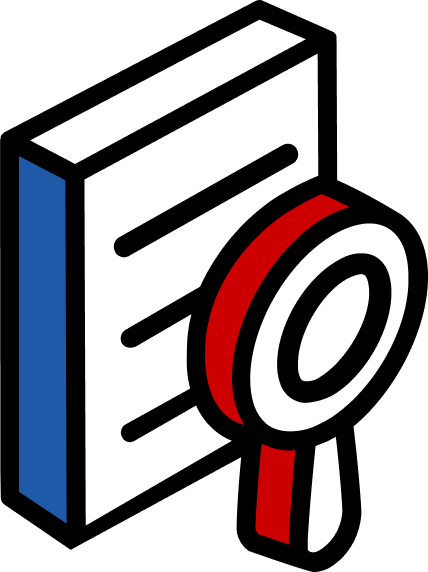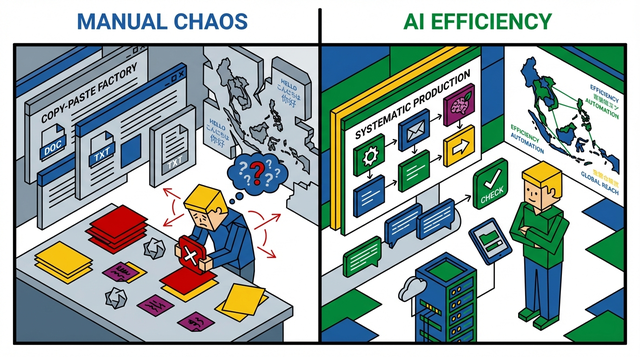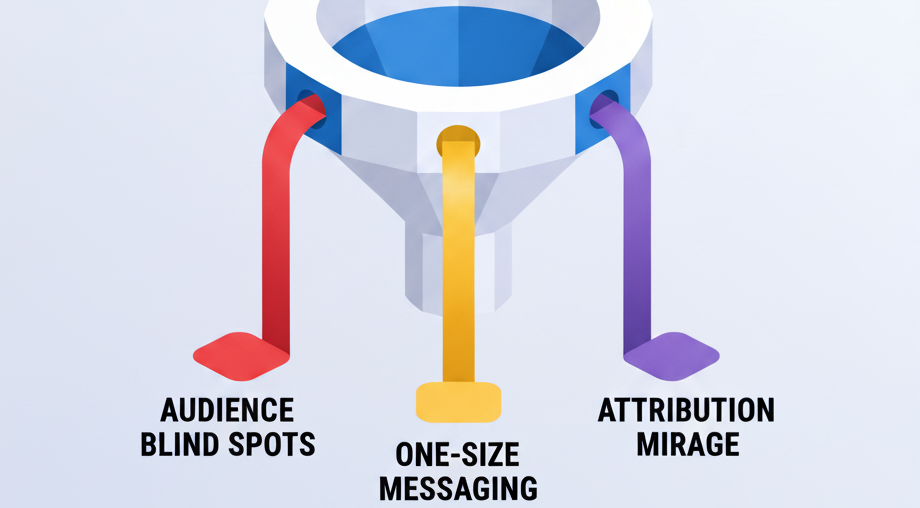Content Outline
From Job Titles to Real Conversations: The B2B Message Personalisation Framework

Sarah, Regional Marketing Director for a B2B fintech company in Singapore, stares at her Monday morning dashboard with growing frustration. Her latest LinkedIn campaign targeting "IT Decision Makers in Southeast Asia" shows a dismal 0.3% click-through rate despite a $15,000 monthly budget.
Meanwhile, her biggest competitor's campaign—running parallel ads to the same audience—consistently hits 2.1% CTR with messaging that speaks directly to specific pain points: "CFOs struggling with multi-currency reporting" and "IT Directors managing compliance across six markets."
The data from our work with enterprise clients across SEA tells a stark story: generic messaging wastes the buyer insights you fought to earn. Companies implementing B2B message personalisation see average click-through-rate optimisation improvements of 240% and reduce CPL by 34% within eight weeks¹. Yet 73% of B2B marketers in APAC still deploy one-size-fits-all messaging across their entire buying committee².
Sound familiar? You're not alone in discovering this expensive blind spot.
The issue isn't your targeting—it's that you're speaking to everyone and connecting with no one. After mapping your buying groups (the hard work from our previous discussion), you need messaging that hits each persona where they live: their specific role pressures, daily frustrations, and decision-making stage.
The penalty for generic messaging has never been higher. With CPL rising 38% across Southeast Asia³ and buying committees averaging 6-10 stakeholders⁴, every wasted impression compounds. But here's what most B2B marketing SEA teams miss: the solution isn't more creative brainstorms or copywriting courses. It's a systematic approach to role-based messaging that matches words to roles.
The Generic Messaging Tax
The cost of one-size-fits-all copy hits your budget in three compounding ways that most marketing directors don't track until it's too late.
Wasted Impressions at Scale When your ad speaks generically about "digital transformation" or "streamlined operations," you're paying for impressions that bounce off most of your audience. A Regional IT Director dealing with compliance deadlines doesn't connect with messaging about "operational efficiency." A CFO managing budget approvals doesn't engage with technical feature lists.
Our analysis of 847 B2B campaigns across Malaysia, Thailand, and Singapore shows generic messaging achieves 12-15% of the engagement rates versus persona-driven alternatives. When it comes to improving B2B CTR, you're essentially paying for 85% waste.
Qualified Lead Dilution Generic messaging attracts generic inquiries. When your landing page promises to "solve business challenges," you'll receive leads from HR generalists, procurement assistants, and junior analysts—none with budget authority or genuine need for your solution.
Persona-driven copywriting acts as a natural filter. When you speak directly to "Finance Directors managing multi-entity consolidation," you attract exactly that profile. The lead quality improvement typically reduces sales qualification time by 40-60%.
Opportunity Cost Compounding The hidden cost isn't just poor performance—it's missing the revenue that persona-fit messaging would have generated. When SAP's SEA team switched from generic "enterprise software" messaging to role-specific value propositions, their CPL dropped from $1,847 to $312 while pipeline velocity increased 34%⁵.
The math is unforgiving: every month you delay persona messaging optimization, you're paying the generic messaging tax across every impression, every click, and every missed opportunity.
The disconnect is clear: marketing teams invest heavily in buyer persona research, then default to one-size-fits-all messaging when campaigns launch. The gap isn't understanding the importance of personas—it's having a reliable method to turn those insights into persona-driven copywriting that actually converts.
Why Job Titles Don't Equal Personas
The most common messaging mistake I see across Southeast Asian B2B teams is conflating job titles with personas. Targeting "Chief Technology Officers" feels specific, but it's still generic messaging in disguise.
Consider two CTOs at similar-sized companies in Singapore:
CTO #1: Recently promoted from Senior Developer, managing a 15-person team, under pressure to modernize legacy systems while maintaining uptime. His daily reality: "How do I upgrade our infrastructure without breaking everything?"
CTO #2: 15-year veteran, managing 200+ engineers across four countries, focused on strategic technology decisions. His daily reality: "Which platforms scale with our expansion into Vietnam and Thailand?"
Same title. Completely different pain points, decision triggers, and messaging resonance. Generic "CTO-focused" copy connects with neither effectively.
This is where the R.P.S. Framework provides clarity: Role (beyond title), Pain (specific to their situation), and Stage (where they are in the buying journey).
Role goes deeper than org chart position. It's about daily pressures, internal stakeholders, and success metrics. The newly-promoted CTO measures success differently than the seasoned strategic CTO.
Pain isn't just professional challenges—it's the specific friction causing sleepless nights. "System integration complexity" is generic. "Managing API connections across 12 different vendors while ensuring SOC 2 compliance" is specific and actionable.
Stage recognizes that different personas enter your funnel at different points. Finance Directors typically start with budgetary research. Technical teams begin with feature comparisons. Your messaging should match their entry point, not force them through your preferred journey.
The breakthrough happens when you combine all three dimensions. Instead of "Solutions for CTOs," you create "Legacy system modernization for promoted technical leaders managing enterprise security requirements"—copy that speaks to Role (promoted leader), Pain (legacy systems), and Stage (modernisation research).
The R.P.S. Role-Pain-Stage Framework
The R.P.S. role-pain-stage framework transforms persona insights into revenue-driving copy through three systematic layers that build on each other.

Layer 1: Role Mapping (Beyond Job Titles)
Start by identifying the real role dynamics that drive messaging resonance:
Decision Authority: Budget owner, influencer, or end-user recommendation
Internal Pressure: Board reporting, team management, or operational delivery
Success Metrics: Revenue targets, efficiency gains, or risk mitigation
Stakeholder Network: Who they need to convince, report to, or coordinate with
For each persona, create a one-sentence role reality check: "This person's primary job pressure is [X], measured by [Y], while managing [Z] stakeholders."
Example role mappings from our Southeast Asian client work:
- Regional Finance Director: "Primary pressure is accurate multi-entity reporting, measured by audit compliance and month-end speed, while managing country controllers and group CFO expectations."
- IT Security Manager: "Primary pressure is threat prevention without hampering productivity, measured by incident reduction and user satisfaction, while managing vendor relationships and C-suite risk tolerance."
Layer 2: Pain Specificity (The Sleepless Night Test)
Generic pain points don't drive action. "Operational inefficiency" doesn't keep anyone awake at 2 AM. "Manually reconciling invoices from six different systems while the auditors wait" does.
Apply the Sleepless Night Test to each pain point:
- Can you visualise this person lying awake thinking about this specific problem?
- Would they use these exact words when explaining the issue to their spouse?
- Does this pain point have a clear deadline or escalating consequence?
High-converting pain statements include:
- Quantified impact: "Processing payroll for 400 employees across five countries takes our team 40 hours monthly"
- Emotional weight: "Board meetings where I can't explain why our customer acquisition cost jumped 60%"
- Time sensitivity: "Compliance audit in six weeks and our data is scattered across twelve systems"
Layer 3: Stage-Appropriate Messaging
The same persona needs different messaging depending on their buying journey stage. Most B2B teams create one message per persona, missing the stage-specific variations that drive higher conversion rates.
Awareness Stage Messaging: Problem-focused, educational, non-threatening
- "Why multi-entity financial reporting breaks down in high-growth companies"
- "The hidden compliance risks in your current vendor management process"
Consideration Stage Messaging: Solution-category focused, comparative, building urgency
- "How modern FP&A platforms handle Southeast Asian regulatory requirements"
- "Traditional vs. cloud-based approaches to vendor risk management"
Decision Stage Messaging: Vendor-specific, risk-reduction focused, results-oriented
- "How Company X reduced month-end reporting from 12 days to 3 days"
- "Migration timeline and support for companies switching from Legacy System Y"
The R.P.S. Matrix combines all three layers into a systematic messaging approach that scales across campaigns, channels, and markets.
The 3-Step R.P.S. Implementation Playbook
Implementing persona-specific messaging across multiple markets requires systematic execution, not creative inspiration. Here's the proven playbook we've used with B2B tech companies from Series B startups to public enterprises.
Step 1: Build Your Persona Messaging Matrix
Create a structured grid mapping each persona against their stage-specific messaging needs using multi-market copy principles:
Matrix Structure:
- Rows: Your key personas (typically 3-5 for B2B campaigns)
- Columns: Awareness, Consideration, Decision stages
- Cells: Role-Pain-Stage specific message variants
Matrix Development Process:
- Role Research: Interview 2-3 people per persona (customers, prospects, sales team)
- Pain Validation: Use exact language from interviews, not marketing interpretations
- Stage Testing: A/B test stage-appropriate messages against your current generic copy
Example Matrix Entry: Persona: Regional Finance Director | Stage: Consideration Role: Managing multi-entity reporting with limited team Pain: Month-end closes taking 15+ days due to manual consolidation Message: "How finance teams at high-growth SEA companies cut month-end reporting time in half without adding headcount"
Step 2: Channel-Specific Message Adaptation
Different channels require different message depths while maintaining R.P.S. consistency:
LinkedIn Ads (40-60 characters headline): Generic: "Streamline Your Financial Operations" R.P.S.: "Cut Month-End Reporting from 15 Days to 3"
Email Subject Lines (30-40 characters): Generic: "Improve Your Reporting Process" R.P.S.: "[Company]: 15-Day Month-End Problem?"
Landing Page Headlines (60-80 characters): Generic: "Financial Management Solutions for Growing Companies" R.P.S.: "Multi-Entity Reporting That Doesn't Require Weekend Work"
Google Ads (30/90 character limits): Generic: "Financial Software | Free Trial" R.P.S.: "Month-End in 3 Days, Not 15 | See How [Company] Did It"
Step 3: Systematic Testing and Optimization
Most B2B teams test randomly. R.P.S. implementation requires structured testing that builds knowledge systematically:
Week 1-2: Role Testing Test role-specific vs. generic messaging with identical pain points and offers. Track CTR, conversion rate, and lead quality scores.
Week 3-4: Pain Intensity Testing
Compare generic pain ("reporting challenges") vs. specific pain ("15-day month-end closes") with winning role messaging. Track engagement depth and sales qualification rates.
Week 5-6: Stage Alignment Testing Test stage-appropriate messaging vs. one-size-fits-all approaches. Track conversion rates and sales cycle velocity.
Optimization Velocity Framework:
- Test one R.P.S. element per week (not all simultaneously)
- Require 95% statistical significance before declaring winners
- Document winning combinations in your R.P.S. playbook for reuse
- Scale winners across additional channels within 48 hours
The key insight: R.P.S. optimization compounds. Each test builds knowledge that improves subsequent campaigns, creating systematic messaging improvements rather than random creative experiments.
Overcoming the "Localization is Too Complex" Objection
The most common pushback on persona-specific messaging is complexity: "We're already stretched thin managing campaigns across Thailand, Malaysia, Singapore, and Indonesia. Adding persona variations will overwhelm our team."
This objection misses the efficiency gains that R.P.S. framework provides. Instead of creating more work, systematic persona messaging reduces long-term effort while improving results.
The SAP Southeast Asia Case Study
When SAP's regional team faced this exact challenge in Q2 2024, they had generic "enterprise software" campaigns running across five markets with declining performance. CPL had risen from $847 to $1,847 over six months while lead quality scores dropped 23%.
Instead of adding complexity, they used the R.P.S. framework to create systematic efficiency:
Week 1: Role mapping across markets revealed identical personas with locally-specific pain points Week 2: Created master R.P.S. matrix with regional pain variations Week 3-4: Deployed localized campaigns using framework templates
Results after 90 days:
- CPL dropped to $312 (83% improvement)
- Lead qualification rates improved 47%
- Sales cycle velocity increased 34%
- Campaign setup time reduced from 2 weeks to 3 days
The Efficiency Secret: R.P.S. templates scale across markets more efficiently than generic campaigns because the framework handles complexity systematically rather than creatively.
Regional Pain Variations Example: Role: Finance Director, High-Growth B2B Company Core Framework: Month-end reporting complexity with limited team
Singapore Pain: "Regulatory reporting across multiple subsidiaries" Malaysia Pain: "GST compliance reporting with manual reconciliation"
Thailand Pain: "VAT reporting requirements across entity structures" Indonesia Pain: "Multi-currency consolidation with manual exchange rates"
Same role, same stage, localized pain points. The framework creates efficiency, not complexity.
Implementation Reality Check
Start with your highest-value persona in your largest market. Perfect the R.P.S. approach there, then systematically expand to additional personas and markets using the proven template.
Most teams try to implement everything simultaneously and get overwhelmed. The compounding approach—master one persona-market combination, then scale—delivers faster results with less complexity.
Regional Messaging Nuances That Drive Results
Southeast Asian B2B messaging requires cultural adaptations that Western frameworks often miss. These nuances layer onto your R.P.S. framework without replacing it—the role, pain, and stage remain consistent while the approach adapts to local preferences.
Decision-Making Styles
Singapore/Malaysia: Direct, data-driven messaging resonates. Lead with specific ROI calculations and implementation timelines. "Reduce month-end reporting from 12 days to 4 days with automated consolidation"
Thailand/Indonesia: Relationship-focused language increases engagement. Emphasize team collaboration and gradual benefits. "Help your finance team collaborate more effectively while cutting reporting time"
Proof Point Preferences
Data-Heavy Markets (Singapore/Malaysia): Lead with numbers and benchmark comparisons. "Companies similar to yours typically see 40% faster month-end closes within 90 days"
Relationship-Focused Markets (Thailand/Indonesia): Lead with peer references and team success stories. "Finance teams across Southeast Asia are finding month-end reporting doesn't have to consume weekends"
Local Terminology Adaptations
Even English-language campaigns benefit from regional business terminology:
- Malaysia: "Reconciliation" and "consolidation" language
- Singapore: "Integration" and "automation" focus
- Thailand: "Collaboration" and "team efficiency" emphasis
- Indonesia: "Growth support" and "scaling" terminology
Your R.P.S. Quick-Start Checklist
Ready to transform your generic messaging into persona-specific conversion engines? Here's your week-by-week implementation roadmap:
Week 1: Persona-Pain Audit □ List your top 3 personas currently receiving identical messaging □ Document their actual job pressures (not just responsibilities)
□ Identify specific pain points using customer interview language □ Apply the "Sleepless Night Test" to each pain point
Week 2: R.P.S. Matrix Creation □ Build 3x3 matrix (3 personas x 3 stages) □ Fill each cell with specific Role-Pain-Stage messaging □ Validate messaging language with sales team/recent customers □ Create channel-specific headline variations
Week 3: Implementation and Testing □ Launch persona-specific campaigns against current generic versions □ Set up tracking for CTR, conversion rate, and lead quality scores □ Document baseline performance metrics for comparison
Week 4: Optimization and Scaling □ Analyze performance data and identify winning combinations □ Scale successful R.P.S. messages across additional channels □ Begin developing matrix for additional personas/markets
Micro-Copy Optimization Checklist: □ Headlines speak to specific role pressures, not generic benefits □ CTAs match the persona's stage (research vs. evaluation vs. purchase) □ Form fields request information that persona willingly shares □ Thank-you pages continue the persona-specific conversation
Regional Adaptation Checklist: □ Pain points reflect local market conditions and terminology □ Proof points use regionally-relevant examples and benchmarks
□ Cultural tone matches market preferences (direct vs. collaborative) □ Language precision follows local business terminology
The R.P.S. framework isn't theory—it's the systematic approach to transforming your buyer insights into revenue-driving messaging that connects with each persona where they are, not where you want them to be.
"The breakthrough came when we stopped talking to everyone—CTR +180% in 6 weeks."
— Regional Marketing Director, B2B Software Company, Singapore
Ready to Stop Paying the Generic Messaging Tax?
You've invested significant time and budget building detailed buyer personas. Now it's time to see if your current messaging strategy is actually converting those insights into revenue, or if you're still paying the generic messaging tax across every campaign.
The R.P.S. framework provides the systematic approach to transform your persona research into conversion-driving copy, but implementation success depends on understanding exactly where your current messaging gaps exist.
Take the IMPACT Scorecard to discover your persona messaging conversion opportunities across all six pillars of revenue-positive marketing. You'll receive a customized assessment of your current R.P.S. implementation plus specific recommendations for your market and industry.
→ Access Your Free IMPACT Scorecard Assessment
Results delivered in under 5 minutes. Implementation roadmap included.
Want to see how leading B2B companies across Southeast Asia are implementing systematic persona messaging? We've worked with enterprise clients from Singapore to Jakarta, transforming generic campaigns into persona-specific revenue engines. Ready to explore what this looks like for your specific market and industry?
About the Author


Guide
Assess Your IMPACT
Try our IMPACT scorecard to discover how your marketing stacks up across our six-pillar framework. Get a data-driven scorecard that identifies gaps and opportunities for measurable growth.


